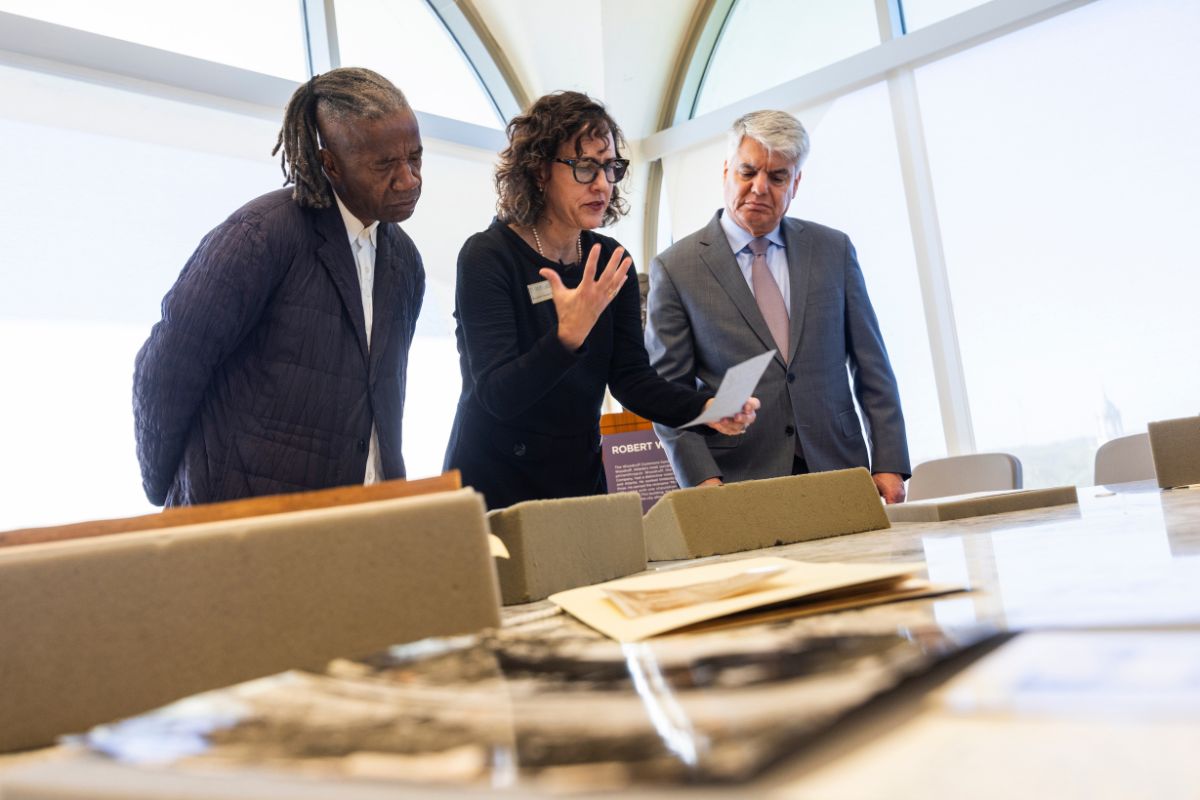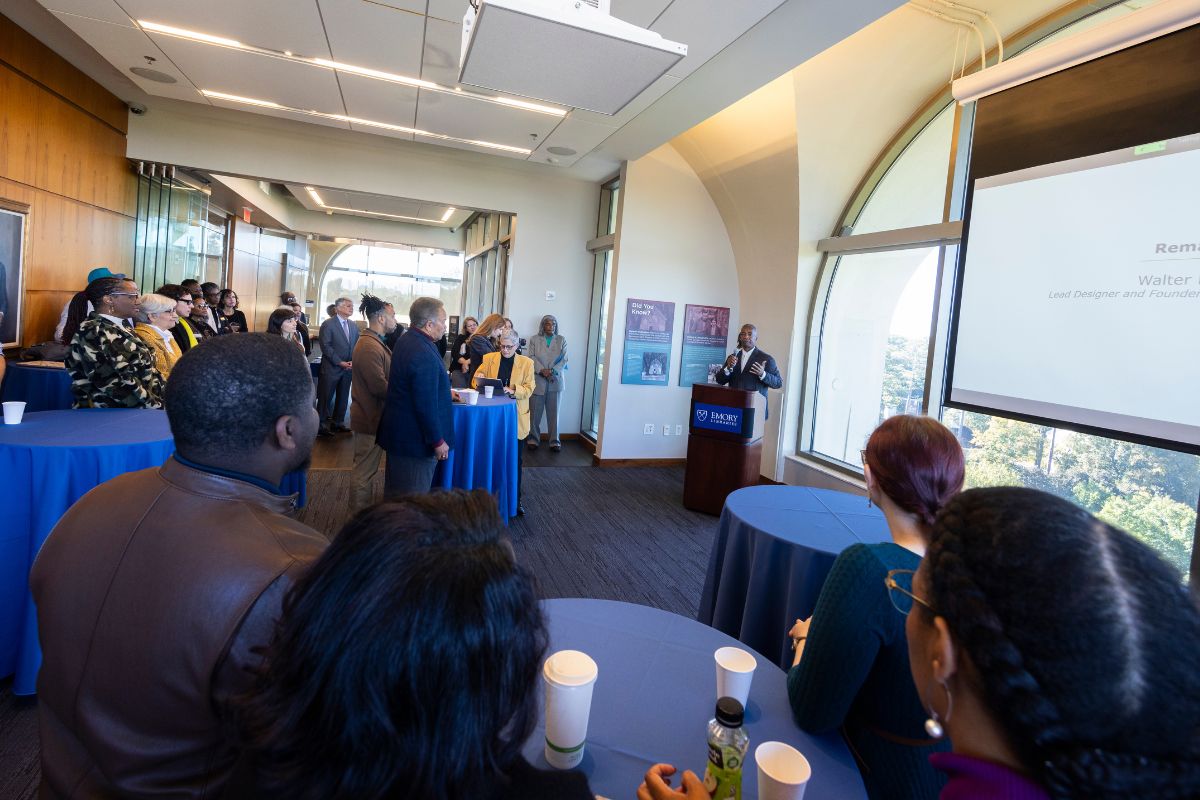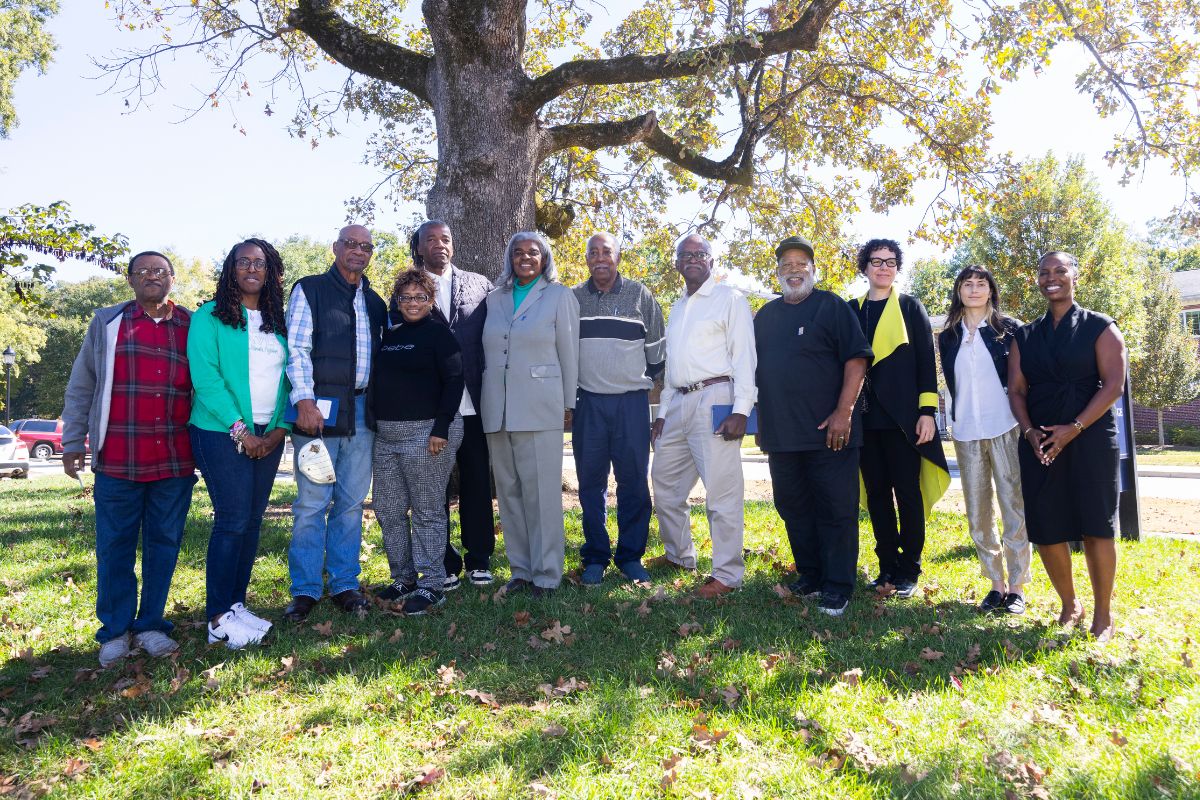Following the selection of the acclaimed Hood Design Studio to create Emory’s Twin Memorials, which will honor enslaved persons who were part of the university’s history, Walter Hood and his team visited the Atlanta and Oxford College campuses.
Welcomed by President Gregory L. Fenves and an enthusiastic contingent of community members involved with the project, Hood — the studio’s founder and creative director — and his staff were guests at an event hosted by the Twin Memorials Project Team in partnership with the Stuart A. Rose Manuscript, Archives, and Rare Book Library. On view that morning were a variety of archival materials that library staff had assembled pertaining to this aspect of Emory’s history.
“This is an important moment for Emory,” Fenves said during the Oct. 17 event, noting that Twin Memorials to honor the enslaved “is a concept that has been discussed, and thought through, at Emory for many years.” Recalling how the concept resonated with him when he began his tenure at Emory in August 2020, Fenves added: “It is an essential, long-overdue recognition, a crucial way to remember, teach and heal for this generation and generations to come.”
Staying ‘in the wake’
Before introducing Hood, Fenves described a visit that he and his wife, Carmel, made to the International African American Museum in Charleston, South Carolina, where the Hood team designed the museum’s landscape architecture. Fenves reflected on the complexity and emotional resonance of what Hood and his team rendered there — “the water reflecting human figures, the outline of the wharf where ships unloaded the enslaved, the native grasses, the trellises with badges, which was a reminder that the enslaved could be rented out.”
In his remarks, Hood began by saying, “We want to create this journey together.” The work of his studio, he emphasized, is not about making monuments but instead exploring the idea of memory.
Invoking the concept of “the wake” — which has several registers, including the path behind a ship, keeping watch with the dead and coming to consciousness — Hood said: “The idea of memory is a very powerful one for our studio. We live in a wake. And the wake means that we have to remember but we have to go forward. How do we create a space that we can return to and actually understand that we are on this journey together? That is the promise of this project. Hopefully, we can get somewhere together that we could not have imagined.”
Oxford’s new dean welcomes the project
Oxford College Dean Badia Ahad movingly closed the session, providing a layered view of the project from her perspectives as dean, as a scholar of African American literature and culture, and as an African American whose ancestors were enslaved persons in Livingston, Alabama.
“It is a privilege to take on this remarkable project as I begin my tenure as dean of Oxford College,” Ahad noted.
She related a year-long school assignment, to construct a family history, that she had in the 8th grade. Initially enthusiastic, she said that she “grew to resent the project, ashamed that my family tree was so sparse. What story could I possibly tell?”
The key was getting to know her grandmother better. “Like most 13-year-olds,” Ahad said, “I was 80% ego and 20% water, so naturally I took my grandmother for granted.”
Over weeks spent at her grandmother’s kitchen table, “I got to know Annie Lowe. I came to understand that her stories were indeed as rich and as grand as those of my peers who could trace their family histories to Jamestown and beyond.”
“There are so many stories of the African American historical past that the archive will never hold,” she continued. “With the Twin Memorials, we have the space to remember, to reconcile, to reflect, to heal and honor the lives and legacies of enslaved persons who built the institution that we freely occupy and enjoy. In this way, we hold in deep regard the path that lay before us that perhaps they could never have envisioned.”
Hood and his team then headed out to Oxford College to meet privately with a group of descendants of the enslaved.
Questions for community input
The Twin Memorials concept-design phase, which will also result in final site selection on both campuses, will continue through spring.
As Hood and his team begin their engagement with the Emory community, they have the benefit of reviewing comments from 26 listening sessions involving more than 225 descendants, administrators, students, faculty, staff, alumni and community partners conducted in 2022. That input is captured in the engagement report of the Twin Memorials Working Group.
In organizing its own engagement sessions at Emory, Hood Design Studio plans to use an organizational principle that they have dubbed “MAPPS.”
Materials: which objects, elements, materials and colors should be used for memorialization?
Activities: what programs are there to preserve, traditions to recognize, new activities to introduce for maintaining the spirit of the sites?
Places: which locations have special meaning and what related/community sites matter?
People: what are the names to remember, people to honor and communities to celebrate?
Stories: what are the narratives to elevate, people to celebrate, pivotal moments to remember and archival sources to include?
Already, since the announcement of the selection of Hood Design Studio at the end of August, the team has connected with 175 descendants, faculty, staff and students on the Atlanta and Oxford campuses virtually and in-person, with more sessions planned, including one for alumni on Dec. 12.



